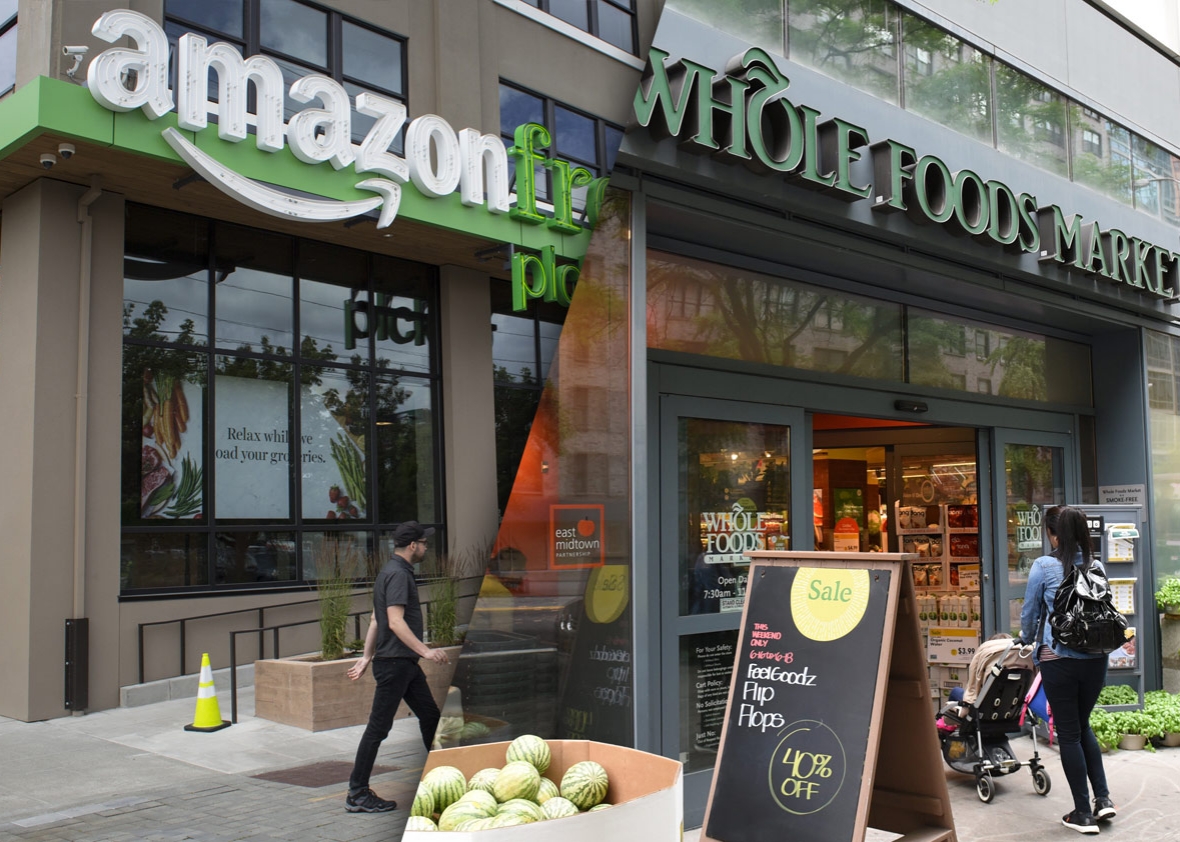
Amazon-Whole Foods deal will change how you buy food forever
For anyone in the business of selling, supplying or hauling groceries: Things just got real.
Amazon.com’s $13.7 billion purchase of Whole Foods instantly makes it a major player in the U.S. grocery industry and that leaves a lot for shoppers, retailers and other companies involved in the industry to chew on.
The online seller is bringing its firepower to a grocery industry plagued by razor-thin profit margins. The move could slice into profits for food manufacturers, other supermarket chains such as the nation’s largest by market share, Kroger, and behemoths like Walmart, which is currently the biggest seller of groceries in the U.S. with more than one-quarter of the market, according to Euromonitor. It also potentially creates a challenge for companies that deliver groceries such as Fresh Direct and Peapod, and ready-to-cook ingredients and recipes to customers’ doors, like Blue Apron and Sun Basket.
“Once Amazon is a player in the industry, anything can go,” said Joe Agnese, senior food retailing analyst at CFRA. “The big threat is what else they can do. Now that they have a retail presence with (more than) 400 stores, long-term they can expand on that threat. They can (bring) pricing pressure. They could bring down prices and everyone would have to match them or lose share.”
For years, Amazon has burst into new areas of business introducing the ease and efficiency of shopping online by bringing books, electronics, clothes, household items and some food items, often at low prices, to shoppers’ front doors. The value, convenience and the ability to easily comparison shop online hastened the demise of both smaller shops and many big household names. Remember bromook superstore Borders? Electronics chain Circuit City?
The broader retail industry’s tailspin has only deepened with Amazon taking a big share of the blame. Once stalwarts of the industry, Sears, J.C. Penney and Macy’s are closing hundreds of stores. Mall favorites like The Limited and Gymboree have filed for bankruptcy protection. Now, traditional grocers could face a similar fate.
►A wave of merger and acquisition activity may be on the way as companies seek scale. Amazon may, itself, be the acquirer. “I don’t think that this will be the last of Amazon’s purchases,” said Rafael Romero, vice president of Florida-based real estate firm CREC’s retail division. “They fully recognize that brick and mortar and online retailing is all retailing and you need both.”
Other companies could look to buy expertise in crunching customer data — an area at which Amazon excels — and one that more shoppers, especially the Millennial generation, embraces.
“I think it’s a great idea,” Trish Wichmann of New York said about Amazon’s reputation for speedy service while out shopping on Friday. “(Consumers are) used to texting. We’re used to instant gratification. That’s what we want. I think industries are trying to do that.”
Big food stores that haven’t been getting information on customers and crunching it are immediately behind. One of Amazon’s strengths is the way it captures purchase history and makes suggestions for new ones.
“Amazon is smart about mining data. They own data like Saudi Arabia has crude oil. Data is going to become only more (important) for those in grocery store business,” said Mark Hamrick, senior economic analyst at Bankrate.com.
►The challenges will extend beyond grocery aisles. Food manufacturers and producers need to gear up for two key possibilities: Amazon nudging itself into shoppers’ carts with food of its own making. It already has its own brand of many items such as batteries and pet food and Whole Foods sells its 365 Everyday Value brand.
The other major threat: Amazon engaging in margin-busting negotiations.
“If Amazon is able to gain the kind of scale they want in this space, they’ll be very tough in commanding a price,” Hamrick said.
Mass retailers now selling groceries, like Walmart and Target, and traditional supermarkets will need to be more competitive to retain customers, especially if Amazon cuts Whole Foods’ high prices.
Walmart had long been the biggest threat to the supermarket industry. In the 1990’s the chain began adding full-line grocery sections to its stores in a bid to increase sales and push foot traffic to the more profitable clothing and general merchandise it sells and Target followed with its own grocery sections. Today, new entrants such as Germany’s Lidl are coming into the market and chains like Aldi (also from Germany) are adding and revamping stores by adding more organic and specialty merchandise such as gluten-free foods, at low prices, to attract shoppers, creating an hyper-competitive environment.




